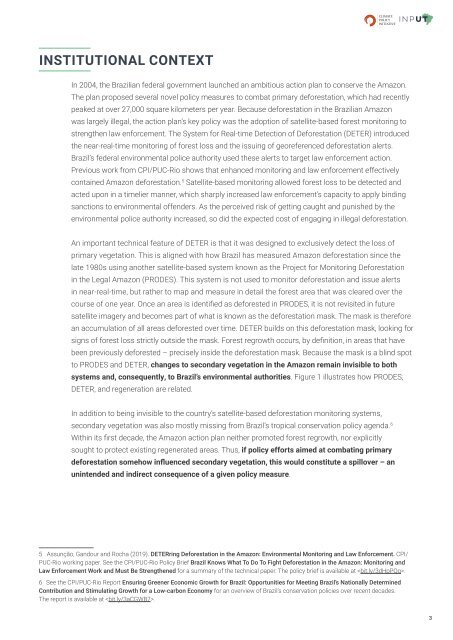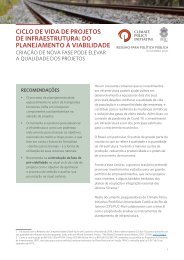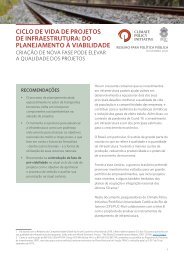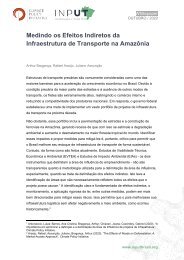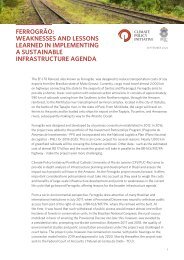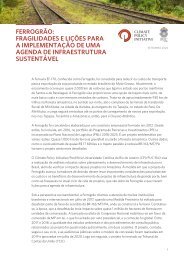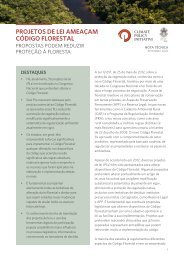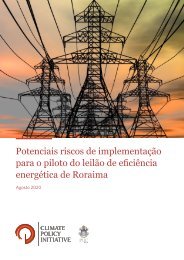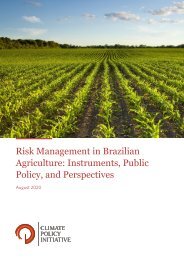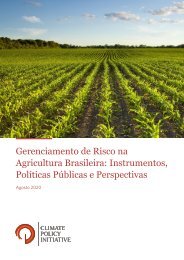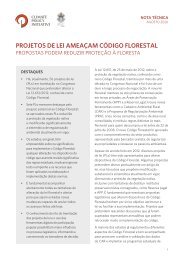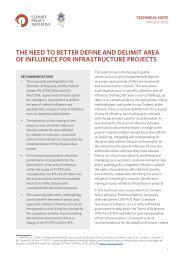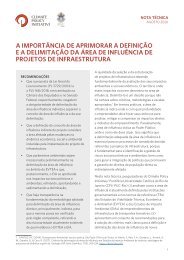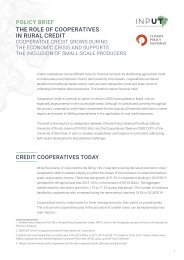Targeting Deforestation, Boosting Regeneration
You also want an ePaper? Increase the reach of your titles
YUMPU automatically turns print PDFs into web optimized ePapers that Google loves.
INSTITUTIONAL CONTEXT<br />
In 2004, the Brazilian federal government launched an ambitious action plan to conserve the Amazon.<br />
The plan proposed several novel policy measures to combat primary deforestation, which had recently<br />
peaked at over 27,000 square kilometers per year. Because deforestation in the Brazilian Amazon<br />
was largely illegal, the action plan’s key policy was the adoption of satellite-based forest monitoring to<br />
strengthen law enforcement. The System for Real-time Detection of <strong>Deforestation</strong> (DETER) introduced<br />
the near-real-time monitoring of forest loss and the issuing of georeferenced deforestation alerts.<br />
Brazil’s federal environmental police authority used these alerts to target law enforcement action.<br />
Previous work from CPI/PUC-Rio shows that enhanced monitoring and law enforcement effectively<br />
contained Amazon deforestation. 5 Satellite-based monitoring allowed forest loss to be detected and<br />
acted upon in a timelier manner, which sharply increased law enforcement’s capacity to apply binding<br />
sanctions to environmental offenders. As the perceived risk of getting caught and punished by the<br />
environmental police authority increased, so did the expected cost of engaging in illegal deforestation.<br />
An important technical feature of DETER is that it was designed to exclusively detect the loss of<br />
primary vegetation. This is aligned with how Brazil has measured Amazon deforestation since the<br />
late 1980s using another satellite-based system known as the Project for Monitoring <strong>Deforestation</strong><br />
in the Legal Amazon (PRODES). This system is not used to monitor deforestation and issue alerts<br />
in near-real-time, but rather to map and measure in detail the forest area that was cleared over the<br />
course of one year. Once an area is identified as deforested in PRODES, it is not revisited in future<br />
satellite imagery and becomes part of what is known as the deforestation mask. The mask is therefore<br />
an accumulation of all areas deforested over time. DETER builds on this deforestation mask, looking for<br />
signs of forest loss strictly outside the mask. Forest regrowth occurs, by definition, in areas that have<br />
been previously deforested – precisely inside the deforestation mask. Because the mask is a blind spot<br />
to PRODES and DETER, changes to secondary vegetation in the Amazon remain invisible to both<br />
systems and, consequently, to Brazil’s environmental authorities. Figure 1 illustrates how PRODES,<br />
DETER, and regeneration are related.<br />
In addition to being invisible to the country’s satellite-based deforestation monitoring systems,<br />
secondary vegetation was also mostly missing from Brazil’s tropical conservation policy agenda. 6<br />
Within its first decade, the Amazon action plan neither promoted forest regrowth, nor explicitly<br />
sought to protect existing regenerated areas. Thus, if policy efforts aimed at combating primary<br />
deforestation somehow influenced secondary vegetation, this would constitute a spillover – an<br />
unintended and indirect consequence of a given policy measure.<br />
5 Assunção, Gandour and Rocha (2019). DETERring <strong>Deforestation</strong> in the Amazon: Environmental Monitoring and Law Enforcement. CPI/<br />
PUC-Rio working paper. See the CPI/PUC-Rio Policy Brief Brazil Knows What To Do To Fight <strong>Deforestation</strong> in the Amazon: Monitoring and<br />
Law Enforcement Work and Must Be Strengthened for a summary of the technical paper. The policy brief is available at .<br />
6 See the CPI/PUC-Rio Report Ensuring Greener Economic Growth for Brazil: Opportunities for Meeting Brazil’s Nationally Determined<br />
Contribution and Stimulating Growth for a Low-carbon Economy for an overview of Brazil’s conservation policies over recent decades.<br />
The report is available at .<br />
3


